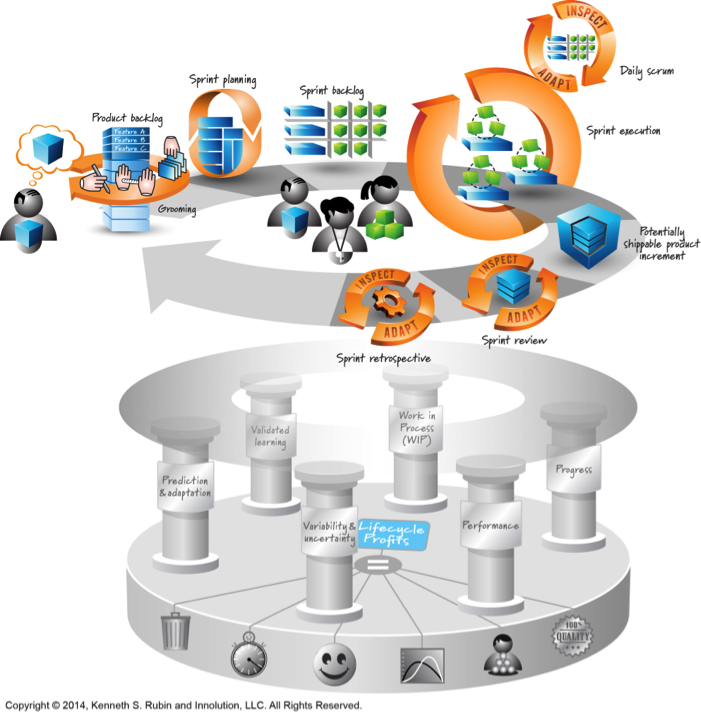I’ve witnessed many teams perform excellent Scrum, from sprint planning through retrospectives, yet their organizations still don’t get the business results they need or expect. Why? Because they fail to perform something I call Economically Sensible Scrum. Economically sensible Scrum is the application of Scrum within an economic framework that is grounded in core agile principles.
I have introduced economically sensible Scrum in my recent blog “Make Better Decisions Using Economically Sensible Scrum” and my article for the Cutter Consortium, “Economically Sensible Scrum: Make Quick, Correct, and Understandable Decisions When Applying Agile.” This blog introduces a new image in the Visual AGILExicon® that illustrates the concept of economically sensible Scrum.
The Visual AGILExicon is a way of describing core Scrum and agile concepts in a graphically rich and visually appealing manner. The pictures in my Essential Scrum book and Innolution’s training classes are based on this new visual lexicon.
Visualizing Economically Sensible Scrum
The image below illustrates the concept of Economically Sensible Scrum.

The image is composed of three parts: the Scrum framework, core agile principles, and the economic framework.
Scrum Framework
The Scrum framework is shown at the top. Many of you will be familiar with this picture, which represents the core practices and artifacts of the Scrum framework. If you’d like, you can watch a video of me describing the details of the Scrum framework using this picture.
Agile Principles
The second part of this image is the pillars, each of which represents a category of core agile and Scrum principles. These principles provide the foundation for understanding and applying the Scrum framework. Implementing Scrum — even by the book— without understanding these principles is one of the leading causes of organizations’ failures with Scrum. People who apply Scrum without understanding its underlying principles lack the necessary context to understand why they are doing things and when and how best to inspect and adapt their approaches.
The principle categories include variability and uncertainty, prediction and adaptation, validated learning, work in process (WIP), progress, and performance. For more details on the principles in each of these categories, please see Chapter 3 of Essential Scrum.
Economic Framework
The final part of this image, the round base at the bottom, is the economic framework that allows us to evaluate decisions that affect multiple interacting objectives. Think of Scrum as a tool based on a set of core agile principles. Teams can use that tool to achieve a variety of objectives during product development, such as eliminating waste, reducing time to market, improving customer satisfaction, exploiting variability, being more effective at creating innovative solutions, and improving quality (depicted in the icons spanning from left to right in the image).
The basic idea is to translate these competing objectives into a normalized unit of measure such as lifecycle profits (an assertion based on Reinersten’s 2009 The Principles of Product Development Flow). Once we convert each objective in to a common unit, we can quickly, correctly, and understandably make decisions when applying agile principles.
Note that the six objectives shown in the economic framework aren’t the only six; they are merely representative of the different types of objectives that companies might be interested in pursuing.
Summary
By combining all three elements (Scrum framework, agile principles, and economic framework) into one image we can show that Scrum is applied in the context of core agile principles which in turn are applied in the context of a sound economic framework for comparing and deciding among competitive business objectives.
The economically sensible Scrum image shown above will be available as part of the Visual AGILExicon® after my keynote presentation at the Scrum Gathering in New Orleans on May 5, 2014, where I will discuss it in detail. You can get a hi-res copies right now of the rest of the pictures in the Visual AGILExicon here.